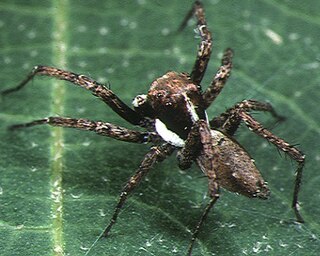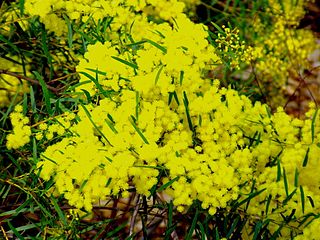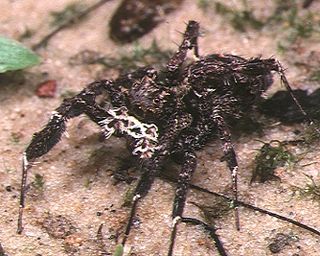
The mata mata, mata-mata, or matamata is a South American species of freshwater turtle found in the Amazon basin and river system of the eastern Guianas. It was formerly believed to also occur in the Orinoco basin, western Guianas and upper Rio Negro–Branco system, but in 2020 these populations were found to belong to a separate species, Chelus orinocensis. Subsequently, some authorities have modified the common name of Chelus fimbriata to Amazon mata mata. These two are the only extant species in the genus Chelus.

Portia is a genus of jumping spider that feeds on other spiders. They are remarkable for their intelligent hunting behaviour, which suggests that they are capable of learning and problem solving, traits normally attributed to much larger animals.

The Coleophoridae are a family of small moths, belonging to the huge superfamily Gelechioidea. Collectively known as case-bearers, casebearing moths or case moths, this family is represented on all continents, but the majority are found in temperate areas of the Northern Hemisphere. They are most common in the Palearctic, and rare in sub-Saharan Africa, South America, and Australia; consequently, they probably originated in northern Eurasia. They are relatively common in houses, they seek out moist areas to rest and procreate.

Cyclopsetta fimbriata, the spotfin flounder, is a species of large-tooth flounder native to the western Atlantic Ocean. It ranges along the Eastern coast of North America, from North Carolina in the north to the coast of Brazil in the south. It is abundant around the coast of Florida and in the Gulf of Mexico. It can be found among reefs and has a depth range of 20–230 metres.

Acacia fimbriata, commonly known as the fringed wattle, Brisbane golden wattle, or just the Brisbane wattle, is a species of Acacia that is native to much of the east coast of Australia. It is one of the floral emblems of the city of Brisbane, Queensland.

Ceratocystis fimbriata is a fungus and a plant pathogen, attacking such diverse plants as the sweet potato and the tapping panels of the Para rubber tree. It is a diverse species that attacks a wide variety of annual and perennial plants. There are several host-specialized strains, some of which, such as Ceratocystis platani that attacks plane trees, are now described as distinct species.

Woodwardia fimbriata, known by the common name giant chain fern, is an evergreen perennial fern species in the family Blechnaceae, in the eupolypods II clade of the order Polypodiales, in the class Polypodiopsida. It is native to western North America from British Columbia through California, including the Sierra Nevada, into Baja California.

Eremaea is a genus of woody shrubs and small trees in the family Myrtaceae and is endemic to the south-west of Western Australia. Little study of the genus as a whole had been undertaken until Roger Hnatiuk researched Eremaea and published a paper in 1993, A revision of the genus Eremaea (Myrtaceae) in Nuytsia. The first species to be described was Eremaea pauciflora in 1837 and by 1964, the number of species known had increased to 12. Hnatiuk recognised 16 species, 5 subspecies and a number of varieties.

Chorizanthe fimbriata, the fringed spineflower, is an annual plant in the family Polygonaceae, the buckwheats. It is a member of the genus Chorizanthe, the spineflowers, and is native to southern California and northern Baja California.
The fimbriate gudgeon is a species of sleeper goby native to the fresh waters of New Guinea and Australia. This species can reach a standard length of 18 cm (7.1 in), though most do not exceed 10 cm (3.9 in).
Drosera fimbriata, the Manypeaks sundew, is a perennial tuberous species in the genus Drosera that is endemic to Western Australia. It grows to 10 to 15 cm tall with two or three whorls of non-carnivorous leaves on the lower portion of the stem and 2 to 5 whorls of carnivorous leaves above that. It is native to a region mostly around Manypeaks but with populations near the Scott River and near Denmark. It grows in winter-wet sandy soils in heathland. It flowers in October.

Drosera sect. Stolonifera is a section of ten tuberous perennial species in the genus Drosera that are endemic to south-west Western Australia. The species all have a similar growth habit and all have fan-shaped leaves, but the morphological differences and lack of natural hybrids support the division of the D. stolonifera species complex.

Chamaexeros is a genus of tufted perennial herbs in the family Asparagaceae, subfamily Lomandroideae.
Corythangela is a genus of moth, belonging to the family Batrachedridae. It was transferred to this family by Baldizonne in 1996.

Leporella fimbriata, commonly known as hare orchid or fringed hare orchid, is the only species in the flowering plant genus Leporella in the orchid family, Orchidaceae and is endemic to the southern Australia mainland. It is related to orchids in the genus Caladenia but has an unusual labellum and does not have hairy leaves. Its pollination mechanism is also unusual.

Purpuradusta fimbriata, common name : the fringed cowry, is a species of sea snail, a cowry, a marine gastropod mollusk in the family Cypraeidae, the cowries.

Purpuradusta is a genus of sea snails, marine gastropod mollusks in the subfamily Erroneinae of the family Cypraeidae, the cowries.

Portia fimbriata, sometimes called the fringed jumping spider, is a jumping spider found in Australia and Southeast Asia. Adult females have bodies 6.8 to 10.5 millimetres long, while those of adult males are 5.2 to 6.5 millimetres long. Both sexes have a generally dark brown carapace, reddish brown chelicerae ("fangs"), a brown underside, dark brown palps with white hairs, and dark brown abdomens with white spots on the upper side. Both sexes have fine, faint markings and soft fringes of hair, and the legs are spindly and fringed. However, specimens from New Guinea and Indonesia have orange-brown carapaces and yellowish abdomens. In all species of the genus Portia, the abdomen distends when the spider is well fed or producing eggs.
Myrmecia urens is a species of ant in the genus Myrmecia found in Australia.

Eremaea fimbriata is a plant in the myrtle family, Myrtaceae and is endemic to the south-west of Western Australia. It is a small shrub with small leaves and single purple flowers on the ends of the branches. The fruits are woody, urn-shaped with a small opening at the top. Unlike other eremaeas which remain dormant during winter, Eremaea fimbriata begins the new year's growth in July or August.














